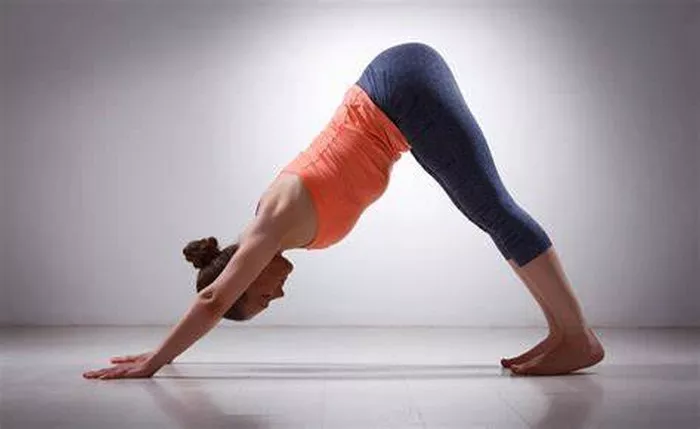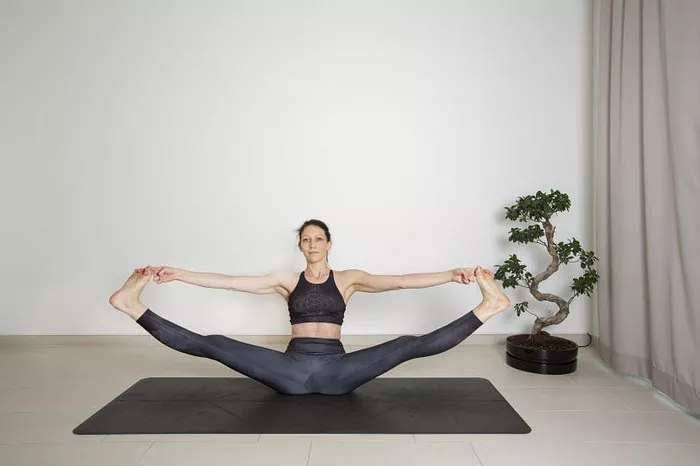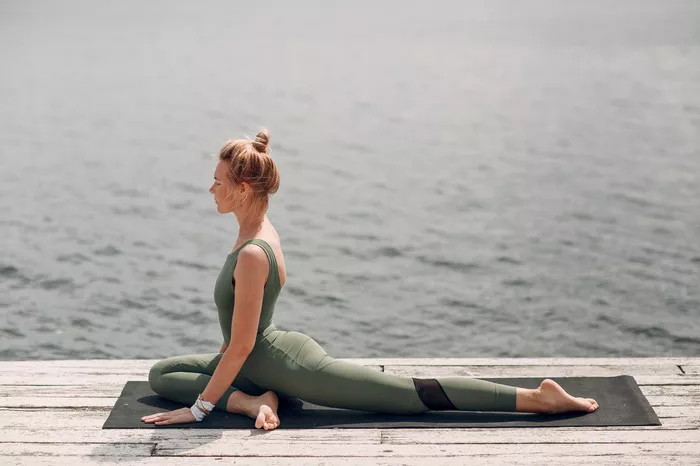The Fish Pose, or Matsyasana, is a widely practiced yoga pose known for its ability to open up the chest, stretch the back, and improve posture. As a beginner, the Fish Pose may seem challenging, but with the proper guidance and practice, it becomes an incredibly beneficial asana. In this article, we will provide a step-by-step guide for beginners on how to perform the Fish Pose, its benefits, precautions, and variations.
What is Fish Pose (Matsyasana)?
The name “Matsyasana” is derived from two Sanskrit words: Matsya meaning “fish” and Asana meaning “pose.” In this pose, the body resembles the shape of a fish, with the chest lifted and the head resting lightly on the floor. Fish Pose is often practiced as a counterpose to the Shoulder Stand (Sarvangasana) because it opens the chest and stretches the front of the body, which helps to neutralize the effects of inversions.
The Fish Pose has a number of physical, mental, and emotional benefits. It strengthens the muscles of the back, enhances flexibility, improves posture, and relieves tension in the neck and shoulders. Additionally, this asana helps with improving breathing capacity and increasing blood flow to the heart.
Benefits of Fish Pose (Matsyasana)
Before diving into the step-by-step instructions for the Fish Pose, it’s important to understand why this asana is so valuable. Here are some of the key benefits:
1. Opens the Chest and Shoulders
Fish Pose is especially beneficial for people who spend long hours sitting or working on computers. It counteracts the rounded shoulders and tightness in the chest by opening the front of the body, allowing for better posture and increased lung capacity.
2. Improves Posture
The chest-expanding nature of Fish Pose helps to align the spine and correct any slouching tendencies. Over time, regular practice of this asana can strengthen the muscles of the back and core, improving overall posture.
3. Relieves Tension and Stress
By stretching the neck and back, Fish Pose can help alleviate tension in these areas, especially for individuals who hold stress in their upper body. It also promotes relaxation and helps calm the mind.
4. Stimulates the Respiratory System
The deep chest opening in Fish Pose encourages diaphragmatic breathing, which is known to reduce anxiety and improve lung function. By stimulating the respiratory system, this asana promotes better oxygenation and can help with breathing-related issues.
5. Improves Spinal Flexibility
Fish Pose provides a gentle backbend that stretches and strengthens the spine. This can help maintain spinal health, improve flexibility, and increase range of motion in the back.
6. Activates the Throat Chakra
As Fish Pose opens the throat and chest, it also stimulates the Vishuddha (Throat) Chakra, which governs communication, self-expression, and creativity. Practicing this pose can encourage better self-expression and a more balanced throat chakra.
7. Boosts Energy and Improves Mood
The chest-opening aspect of Matsyasana helps improve blood circulation and oxygen flow throughout the body. This can increase energy levels, enhance mental clarity, and promote an overall sense of well-being.
Step-by-Step Guide: How to Do Fish Pose (Matsyasana) for Beginners
Although Fish Pose may seem intimidating at first, breaking it down into manageable steps can make it easier to practice. Here’s a step-by-step guide for beginners:
Step 1: Preparation
Before you begin the Fish Pose, make sure you are on a stable, non-slippery surface, such as a yoga mat. You should also be wearing comfortable clothing that allows for full range of motion. To prepare your body for the Fish Pose, do a few rounds of gentle stretches for the neck, shoulders, and spine.
Step 2: Start in a Reclining Position
Begin by sitting on the floor with your legs extended out in front of you, keeping your feet together. Keep your spine straight and engage your core muscles. You can also sit on a folded blanket or cushion to help elevate your hips if you find sitting on the floor uncomfortable.
Step 3: Position Your Hands Underneath Your Hips
Now, place your hands beneath your hips with your palms facing down. Your arms should be straight with your elbows pressing firmly into the floor. This will help support your lower back as you begin to move into the backbend.
Step 4: Lie Back and Press Your Forearms Into the Floor
Slowly begin to lower your back toward the floor, keeping your forearms firmly pressed into the ground. As you lower yourself, engage your core to support your spine. Your elbows should stay directly beneath your shoulders for proper alignment.
Step 5: Lift Your Chest and Arch Your Back
Next, begin to lift your chest upward and arch your back, pressing the crown of your head gently onto the floor. Your neck should remain neutral, not straining forward or back. Your elbows should remain bent, and your forearms should provide support to the backbend.
Step 6: Position the Head and Neck
Once your chest is lifted and your back is arched, place the crown of your head gently onto the floor. The top of your head should rest lightly on the mat, with the weight distributed evenly between your neck and the back of your skull. Keep your gaze straight ahead or slightly upwards.
Step 7: Hold the Pose and Breathe
Now that you are in the Fish Pose, focus on taking deep, slow breaths. As you inhale, try to expand your chest and fill your lungs fully. As you exhale, deepen the stretch and release any tension. Aim to hold the pose for 20 to 30 seconds, gradually working up to 1 to 2 minutes with consistent practice.
Step 8: Come Out of the Pose Safely
To release the pose, slowly lift your chest off the floor and come back to the neutral position. Lower your head and slowly slide your hands out from beneath your hips. Take a moment to rest in a seated position with your spine upright to allow the body to recalibrate.
Tips for Beginners
Here are some tips to help you practice Fish Pose safely and effectively:
1. Start with a Modified Fish Pose
If you’re new to Fish Pose, it’s helpful to start with a modified version. Instead of placing your head on the floor, you can keep your head lifted and supported by a cushion or bolster. This will help you get used to the chest opening without straining your neck.
2. Use Props for Support
You can use props such as a block or cushion under your back to support your spine as you practice Fish Pose. Placing a block between your shoulder blades can deepen the backbend and provide more support.
3. Engage Your Core
As you perform the backbend, make sure to engage your core muscles to support your lower back. This will help you maintain stability in the pose and prevent any unnecessary strain on the spine.
4. Listen to Your Body
Always listen to your body and practice within your limits. If you feel any pain or discomfort, especially in your neck, lower back, or shoulders, come out of the pose and adjust your alignment or use props for support.
5. Breathing
Focus on breathing deeply and steadily throughout the pose. This will help you relax into the stretch and make the pose more effective.
Common Mistakes to Avoid
While practicing Fish Pose, it’s important to avoid common mistakes that could lead to strain or discomfort. Here are a few tips on what not to do:
1. Arching the Lower Back Excessively
Avoid pushing your lower back into the floor too forcefully. Instead, focus on lifting your chest while maintaining a natural curve in the lower back. Overarching the lower back can cause strain and discomfort.
2. Straining the Neck
Ensure that the weight of your body is evenly distributed between your neck and the back of your head. Avoid putting excessive pressure on your neck by pressing your head too forcefully into the floor.
3. Tensing the Jaw or Face
Keep your facial muscles relaxed while practicing Fish Pose. Tensing your jaw or face can increase unnecessary tension in your body and detract from the benefits of the pose.
Precautions and Contraindications
While Fish Pose is generally safe for most people, there are some precautions to keep in mind:
- If you have neck, back, or shoulder injuries, or if you suffer from chronic pain in these areas, consult a healthcare professional before attempting this pose.
- Pregnant women should avoid performing Fish Pose during their second or third trimesters.
- Individuals with heart problems or high blood pressure should practice Fish Pose with caution or avoid it altogether.
Variations of Fish Pose
For those who find the traditional Fish Pose challenging, here are some variations you can try:
1. Supported Fish Pose
In this variation, you can use a bolster or block placed along the length of your spine to support your body as you lie back. This modification provides more comfort and support, especially for beginners.
2. Half Fish Pose
Instead of fully lifting your chest and placing the crown of your head on the floor, you can keep your head and neck lifted, gently arching your back. This is a gentler version of Fish Pose that still opens the chest and strengthens the back.
3. Fish Pose with Legs Extended
In this variation, you keep your legs straight and extended on the floor while performing the chest opening. This variation requires more flexibility in the hips and legs but provides an added stretch for the entire body.
Conclusion
Fish Pose, or Matsyasana, is a powerful yoga pose that offers numerous benefits for the body and mind. With regular practice, this asana can help improve posture, release tension, and enhance overall flexibility. By following the step-by-step instructions, being mindful of your body’s limitations, and practicing with patience, beginners can gradually master Fish Pose and enjoy its many rewards.
Remember, yoga is a journey, and every step you take brings you closer to greater strength, flexibility, and mindfulness. Keep practicing, and enjoy the deep, restorative benefits of the Fish Pose!
Related topics























